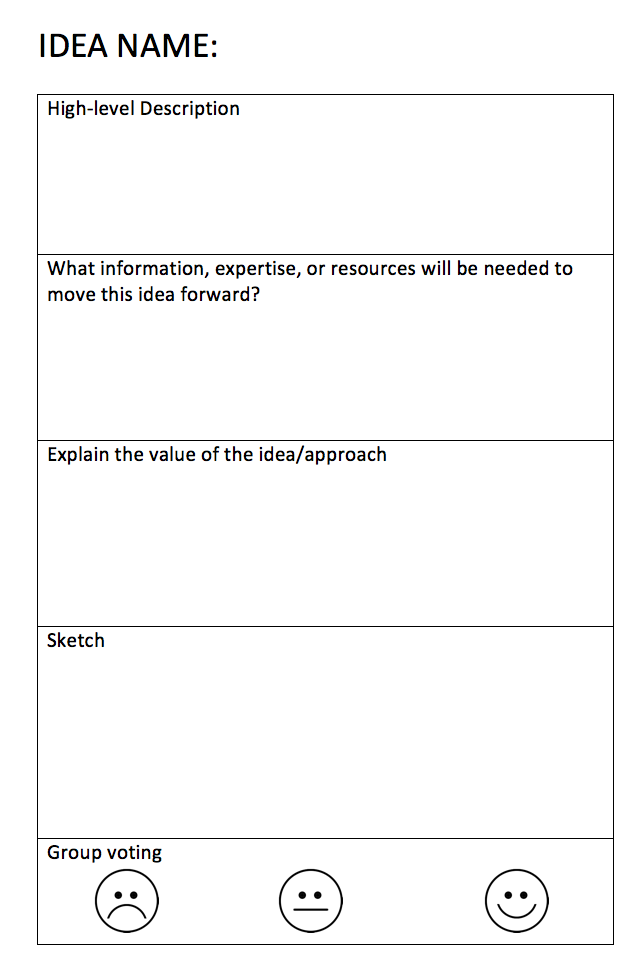
Creativity and Ideation
ENT4934 - Summer 2023 - Florence Italy
This course blends creativity and critical thinking with collaborative ideation methods for energized and inspired problem-solving and solution development.
Note: Design Thinking activities can be conducted live and in person with sticky notes and whiteboard, or virtually online utilizing collaborative tools such as Zoom and Miro with virtual sticky notes and whiteboard.
Week 1: Basics of Creativity, Ideation and Innovation
Get to know each other
Introductions around the table
Gain an appreciation for your own creativity and that of others
Doodling exercise - freeform doodle for 15 minutes
Witness the synergy of two creative people
Pass your doodle to the left and add to your neighbor’s doodle
Define Design Thinking
Apply the Medici Effect to a simple tool, a paper clip
Observe and appreciate innovation in the community
Walk the neighborhood and capture 5 photos of innovative objects that serve a purpose.
Gain a functional use of Miro Digital Whiteboard
Upload your favorite photo to the Miro board at
https://miro.com/app/board/uXjVM53jXw0=/?share_link_id=55187847483
Identify inventions ripe for innovation through
Add a descriptive write-up of your photo and the purpose that it serves
Create a How Might We question for the object identifying who it helps and how it helps.
Identifying necessary variables for the object to serve its purpose
List the criteria for success of the object
Week 2: Ideation Methods
Learning Objectives
Implement 7 methods of innovation from the Innovation Genome Project [60]
Recognize different types of bias (Bicycle Video) [20]
Identify a campus problem ripe for innovation [10]
Conduct basic empathy research [20]
Brainstorm on a First Burst Affinity Map (video & activity) [20]
Implement Brain Writing for your best idea [20]
Practice Solutions A-Z [15]
Think Wrong to develop out of the box solutions (video & activity) [20]
Implement Brand Hijacking to get at unique, new solutions [20]
Read on for detailed instructions
Videos
Why are Ideation and Brainstorming important to Design Thinking? Iconic innovators, Dave and Tim Kelley, hash it out and share their experiences.
Why are innovative ideas so hard to come up with? Destin explains how cognitive bias weighs down our ability to think in new ways using a backward bike to demonstrate.
How do you break free from the status quo to create radical solutions? John Bielenberg has some recipes for success beginning with thinking wrong.
Watch Bill’s video up to 16:04 to learn about LUMIAMI.
Have several teams of one to four students brainstorm for 20 minutes, using LUMIAMI, to come up with unique solutions to this Innovation Target:
Adjusting the mission and services of a local grocery store to compete favorably against big grocery chains using an innovative idea.
After 20 minutes of brainstorming, each team should give their best solutions or initiative a name, and write them on idea cards along with a paragraph description, to present to the class.
The class rates each idea on a scale of 1 - 10 for Wildness (wow factor) and Worldliness (feasibility). Ideas are then mapped on Wild World chart. Which ever idea comes closest to 10/10 wins!
Now watch the rest of Bill’s video.
When you’ve finished, check out this grocery store innovation from Amazon!
Mental Agility Warmup: Solutions A-Z
Come up with possible solutions to your design challenge utilizing every letter of the alphabet. For example, if you were working on Amazon’s shipping challenge, you might come up with [A]utomated robotic delivery, [B]ulk buying discounts, [C]ustomer pickup locations, [D]rones, etc. As a team, fill out at least one sticky note for each letter within five minutes.
2. BRAINSTORMING TEAM EXERCISES
The Brainstorming Mindset
Go for quantity. Ideation is about generating as many ideas as possible, pushing your creativity, and building off one another's ideas. Crazy is encouraged!
Don't Judge. Tap into everyone's creativity by being supportive. What seems unfeasible to you might be part of a great, disruptive concept. Don't shut people down. Instead respond with “yes! and…”
Your sticky note is your voice. Write ideas down with just a few words. Use sticky notes to record your ideas, even if someone else is talking, capture it, and share it!
Be Respectful. Ideation is energizing, and people can get excited. Make room for everyone, encourage introverts to share. Listen attentively and affirm understanding.
2a FIRST BURST AFFINITY MAP
GET IDEAS OUT OF YOUR HEAD AND INTO THE WORLD!
Silently, independently, brainstorm, writing down all your ideas for SOLUTIONS to your HMW - serious, crazy, and everything in between, on sticky notes.
When you’ve accumulated a significant amount of sticky notes (ideas) share them with the group as you post them on the whiteboard.
Group and cluster your ideas as they start to build up on the whiteboard. Label groupings.
Take photos/screenshots, keep your board in tact for others to examine in the next step.
2b THINK DIFFERENT - Gallery Stroll
FIND INSPIRATION ELSEWHERE!
Cycle around the room or virtual break-out rooms and check out other group's affinity maps related to different HMW’s than your own.
Are there any solutions to other HMW’s that spark an idea for your own?
Return to your table and repeat Activity Part 1 harvesting and sharing new ideas and adding them to your Affinity Map.
Take photos/screenshots, keep your board in tact for the next step.
2c THINK WRONG
GET OUT OF YOUR RUT!
In this exercise you will utilize interesting, random, unrelated words to seed new ideas for a solution to your design challenge.
Classroom Version
Walk to your assigned territory on campus (plan to be back to class within 20 minutes).
Wander independently (not as a group) and closely observe the environment seeking visually interesting frames to photograph - this could be anything from the texture of the grout between the bricks, to the architecture of a building, to a cloud in the sky, to the expression on a statue’s face, whatever you find interesting (see https://tinyurl.com/thinkwrong for examples).
Capture three to six interesting interesting photos.
Return your group table in the classroom no later than 30 minutes into class time.
Upload your favorite one or two photos to a shared drive at https://tinyurl.com/thinkwrong.
Add a creative descriptive two-word "comment" to your photo(s). For example: “Measured Airflow,” “Fractured Fire,” ‘Thoughtful Student,” or “Separate Ideas.”
Elect one group member to randomly select any two photos from the entire album at https://tinyurl.com/thinkwrong. One method might be to close eyes, scroll and point, another might be to choose a number between 1 and 100, then find that number photo in the album.
At the top of your whiteboard, write down the four words found in the comments of the two photos you selected.
Build another Affinity Map, or build onto the Affinity Map from Activity 1, brainstorming independently and then as a group on ways in which your words - all together, individually, or in some subset, can be applied to inspire a new solution to your Design Challenge. Experiment with changing the order of the words to see if that sparks any new ideas.
When finished, take a photo of your Affinity Map for future reference.
Online Alternatives
Rather than wandering campus taking phonos as instructed above, utilize photos from previous semesters by randomly selecting two photos from https://tinyurl.com/thinkwrong, and using their two words. for a total of four random words.
-OR- generate four random words using https://randomwordgenerator.com/
At the top of your whiteboard, write down the words you randomly generated.
Build another Affinity Map, or build onto the Affinity Map from Activity 1, brainstorming independently and then as a group on ways in which your words - all together, individually, or in pairs, can be applied to inspire a new solution to your Design Challenge. Experiment with changing the order of the words to see if that sparks any new ideas.
When finished, take a photo of your Affinity Map for future reference.
2d Brand Hack
Your team has been taken over by a prestigious company., develop ideas that fit under your new brand. For example, if you were taken over by Ikea, you might consider ways to flat pack your solution. Disney might provide a solution that was a themed experience, AirBnB might empower the public to provide services needed in order to make some extra cash.
3. BRAIN WRITING (optional)
This activity is all about building off of other people's ideas to think imaginatively about the details of an idea.
Sit with your team around a table or in a virtual breakout room.
Each person take two minutes to simultaneously write out their favorite idea for a design solution on a blank sheet of letter size paper, or in different areas of a chared virtual whiteboard.
After two minutes, everyone passes their paper to the left or moves to a teammates area.
Everyone reads their teammates idea, and takes two minutes to build on the idea with more details or features.
Repeat the above two steps until everyone gets their original idea back.
Review and discuss the ideas that were generated.
Save the sheets for future reference.
4. IDEA FILTERING
It’s time to start filtering and selecting which ideas to move forward. In this activity, you begin to combine and narrow your ideas to converge on a solution.
Decide on the very best ideas that were generated through all of the methods above and pull them into the semi-finalist area for consideration.
Each team member fill out an Idea Card for your favorite solution. There should be at least three unique favs.
Formulate unique descriptive names for each idea.
Draw a priority map on the whiteboard (real or virtual), and as a group, plot each idea card on the priority map (with tape if needed). Discuss each card as it is plotted.
The cards that are closest to the top right corner of the priority map should naturally present themselves as the best ideas. However, if the group is unable to agree on the best idea, utilize the Group Voting box on the idea card to vote for each idea. Each team member should place a hash mark below the emoji that best represents their feelings on each idea. Dot voting might also be considered as a voting mechanism. The ideas with the most smile hash-marks should be seriously considered for moving forward even if it is not the highest on the graph.
Take a photos/screenshot of your populated Priority Map
Take photos of the idea cards for the best three ideas as voted on by the group. Indicate which is the winner!



